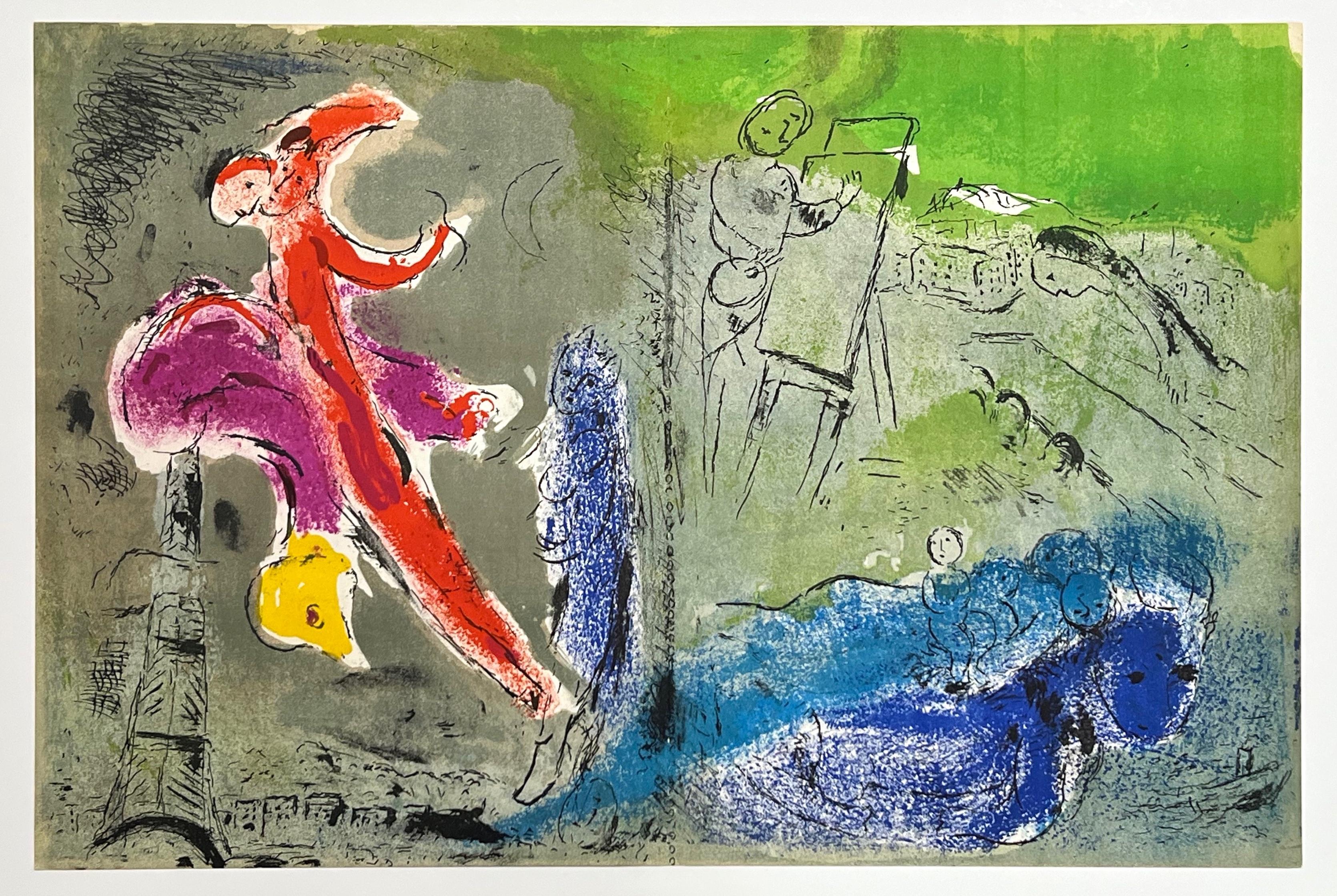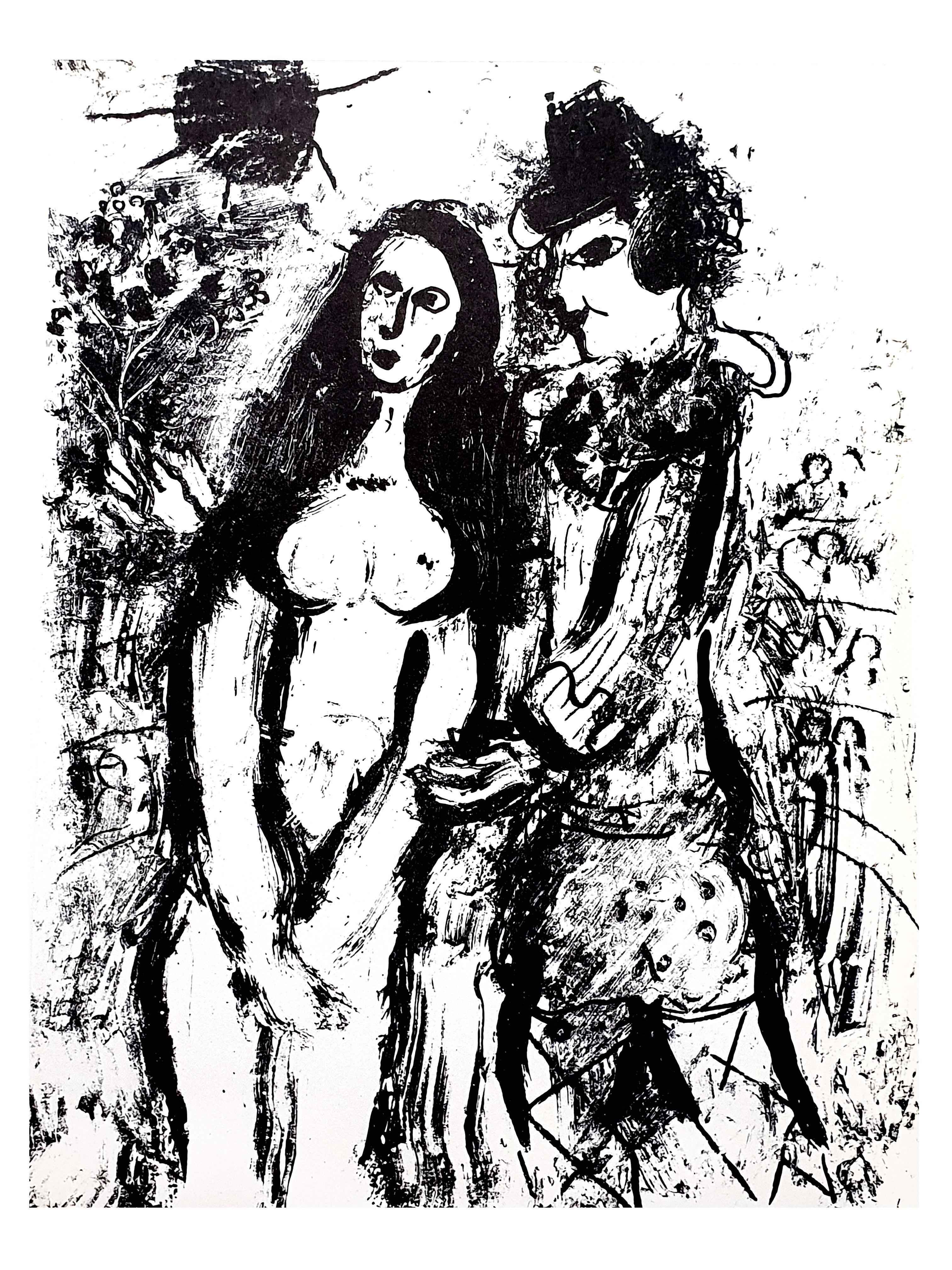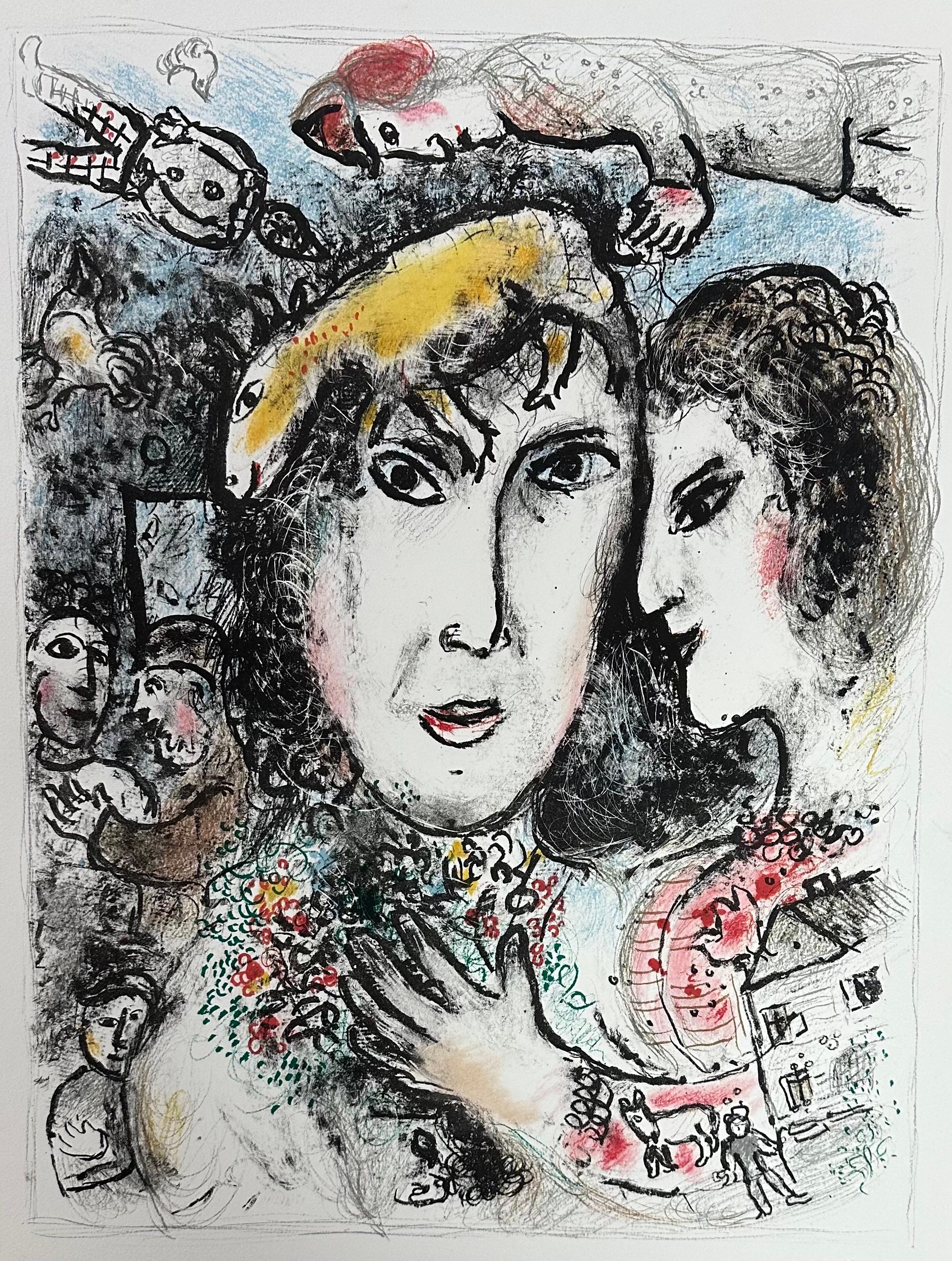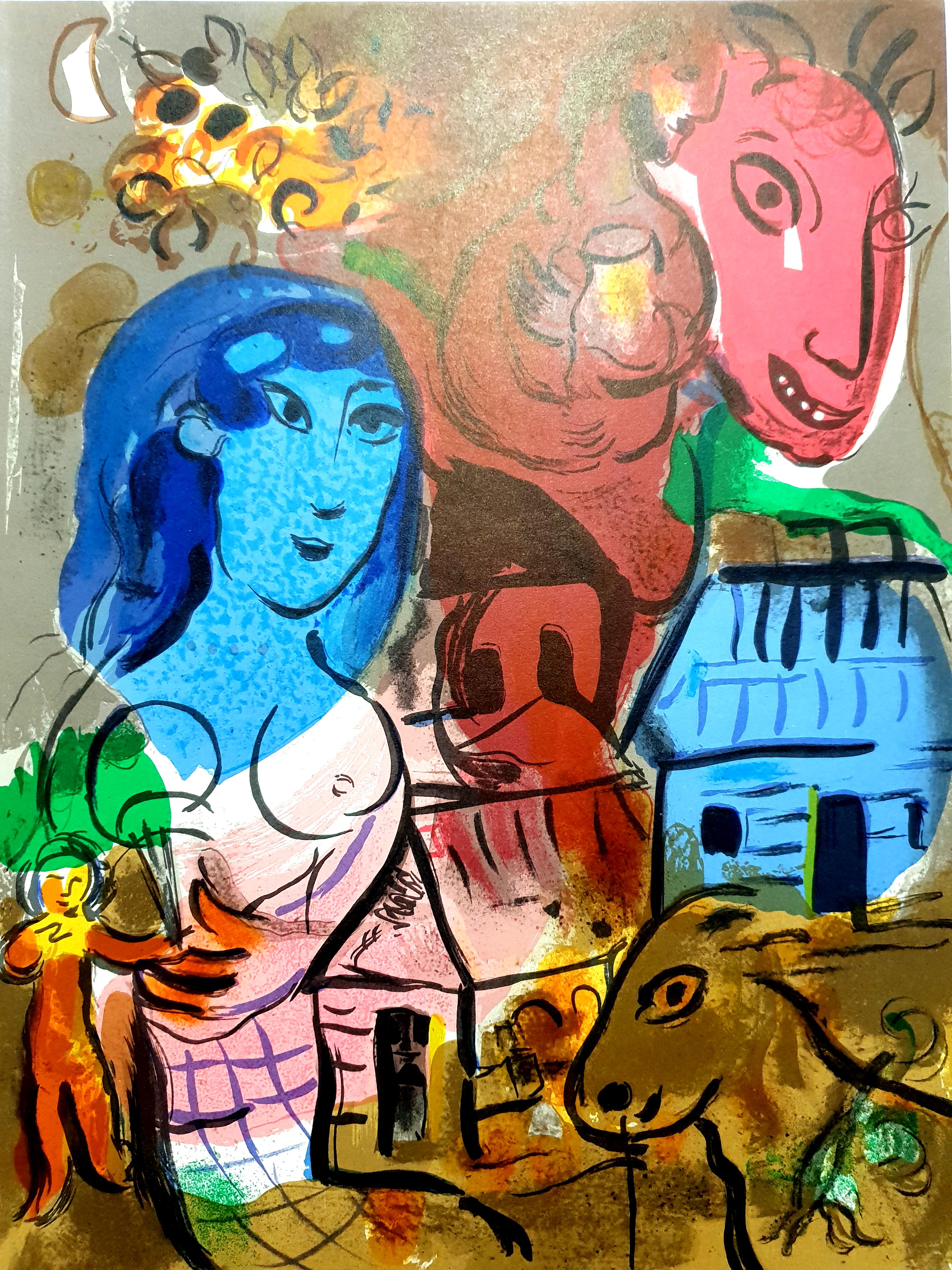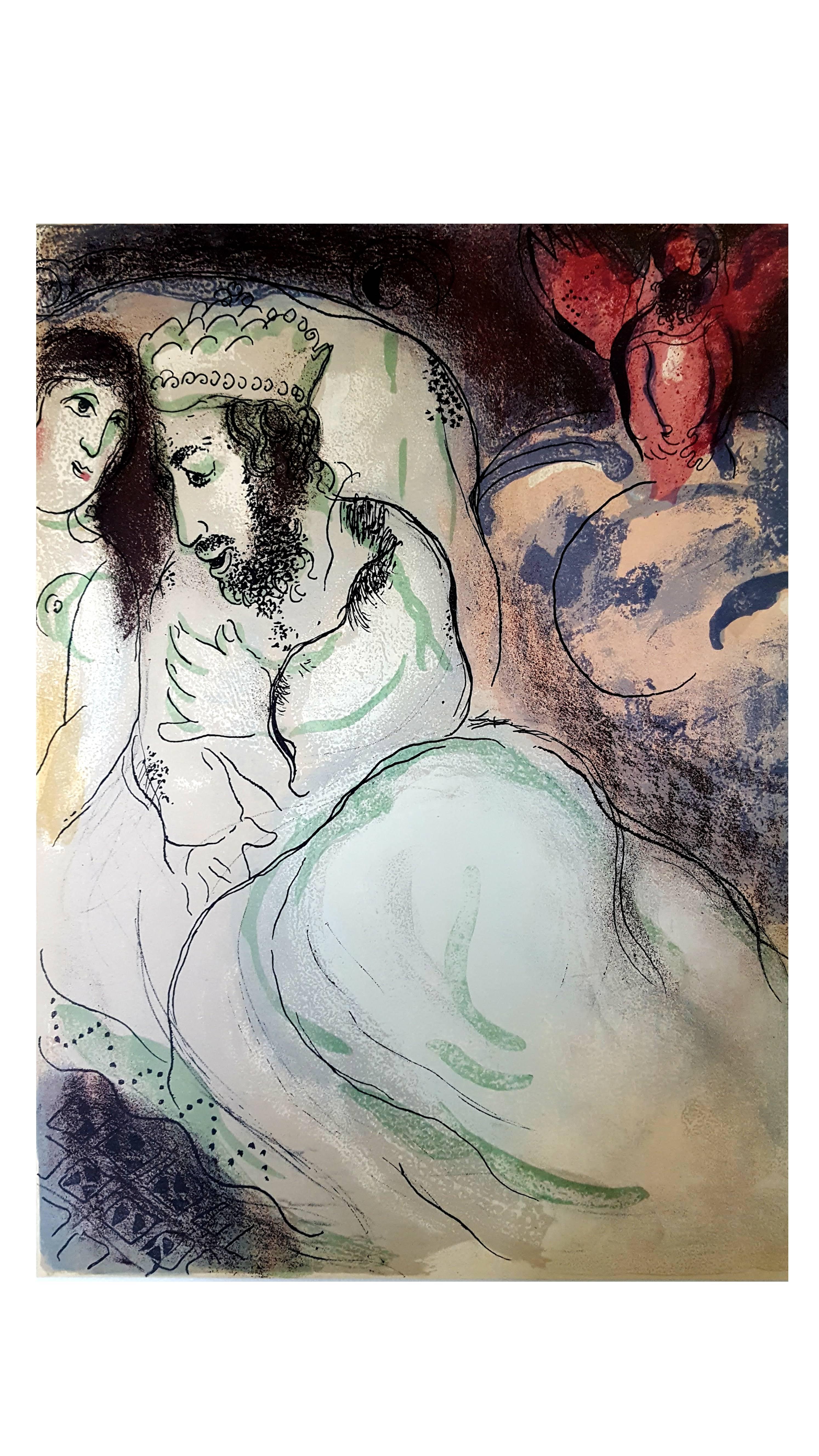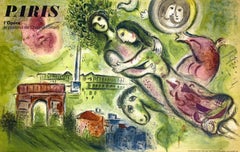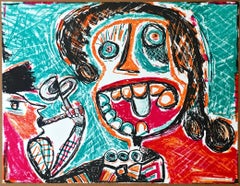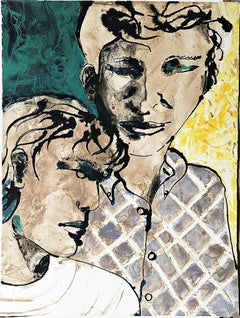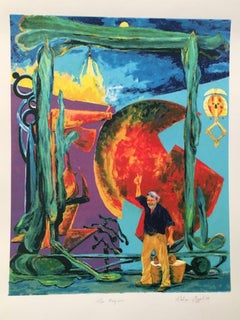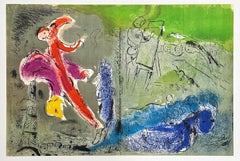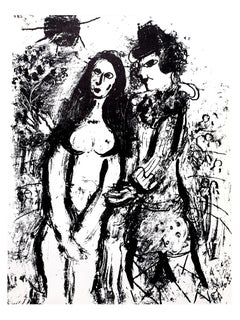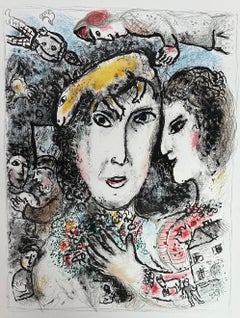Items Similar to Marc Chagall and Charles Sorlier, Carmen, Lithograph, signed 98/150 Mourlot CS39
Want more images or videos?
Request additional images or videos from the seller
1 of 7
Marc Chagall and Charles Sorlier, Carmen, Lithograph, signed 98/150 Mourlot CS391966
1966
$10,000
$15,00033% Off
£7,482.20
£11,223.3033% Off
€8,683.69
€13,025.5333% Off
CA$13,923.77
CA$20,885.6533% Off
A$15,661.15
A$23,491.7333% Off
CHF 8,123.10
CHF 12,184.6433% Off
MX$189,981.17
MX$284,971.7633% Off
NOK 102,996.06
NOK 154,494.0933% Off
SEK 96,925.06
SEK 145,387.5933% Off
DKK 64,782.79
DKK 97,174.1933% Off
Shipping
Retrieving quote...The 1stDibs Promise:
Authenticity Guarantee,
Money-Back Guarantee,
24-Hour Cancellation
About the Item
Marc Chagall (After) and Charles Sorlier (his collaborator and printer)
Carmen, Metropolitan Opera, New York City, 1966
Color Lithograph on Arches watermarked Paper with deckled edges
Hand signed in black crayon lower right front; hand numbered in white crayon and numbered 98 from the edition of 150
Frame included: elegantly floated and framed in a handmade wood frame, with an elegant, desirable raised float - under UV plexiglass
Measurements:
Framed:
43.75 inches vertical by 36 inches by 2 inches
Print:
39.5 inches vertical by 30 inches (horizontal)
Signed and numbered from the limited edition of only 150. This hand-signed lithograph was printed for the opening of Georges Bizet's Carmen, the first performance at the Metropolitan Opera House at New York's Lincoln Center. The image is a detail taken from Marc Chagall's preliminary rendering of his famed mural The Triumph of Music, which is still on display in the opera house. This is the first version of this lithograph to have text. This impression comes from the signed and numbered edition of 150. (Separately, there was also an edition of 200 without text and an unsigned, unnumbered poster edition of 3,000 on different paper), A second version was published the same year, without the text and with the addition of a bird in the lower left corner and a woman and child in the upper right corner. There was also a slightly larger signed edition of 200 -- but this edition of only 150 is considered the most desirable. This is the highly desirable hand signed and numbered edition of 150, on Arches watermarked paper with deckled edges, created for the benefit of the Metropolitan Opera. Hand-signed in black crayon lower right Chagall and numbered in white crayon. It was commissioned by Lincoln Center for the Performing Arts for the Vera List Art Poster program for the American Federation of the Arts. Transcribed by Charles Sorlier from Chagall’s maquette for “The Triumph of Music,” with the annotation “D’APRES MARC CHAGALL – CH. SORLIER GRAV.” added to the stone lower left. Published by Editions of the Metropolitan Opera, New York; printed at Atelier Mourlot, Paris, bearing its credit line on the stone lower right.
Catalogue Raisonne Reference:
Catalog: Mourlot CS39; Chagall’s Posters Catalogue Raisonné p. 108.
Measurements:
Framed:
43.75 inches vertical by 36 inches by 2 inches
Print:
39.5 inches vertical by 30 inches (horizontal)
- Creation Year:1966
- Dimensions:Height: 43.75 in (111.13 cm)Width: 36 in (91.44 cm)Depth: 2 in (5.08 cm)
- Medium:
- Movement & Style:
- After:Marc Chagall (1887 - 1985, French)
- Period:
- Condition:Very good condition with no issues.
- Gallery Location:New York, NY
- Reference Number:1stDibs: LU1745214856652
About the Seller
5.0
Platinum Seller
Premium sellers with a 4.7+ rating and 24-hour response times
Established in 2007
1stDibs seller since 2022
440 sales on 1stDibs
Typical response time: 2 hours
- ShippingRetrieving quote...Shipping from: New York, NY
- Return Policy
Authenticity Guarantee
In the unlikely event there’s an issue with an item’s authenticity, contact us within 1 year for a full refund. DetailsMoney-Back Guarantee
If your item is not as described, is damaged in transit, or does not arrive, contact us within 7 days for a full refund. Details24-Hour Cancellation
You have a 24-hour grace period in which to reconsider your purchase, with no questions asked.Vetted Professional Sellers
Our world-class sellers must adhere to strict standards for service and quality, maintaining the integrity of our listings.Price-Match Guarantee
If you find that a seller listed the same item for a lower price elsewhere, we’ll match it.Trusted Global Delivery
Our best-in-class carrier network provides specialized shipping options worldwide, including custom delivery.More From This Seller
View AllParis L' Opera Le Plafond Romeo and Juliet Place de la Concorde Lt Ed Lithograph
By Marc Chagall
Located in New York, NY
Marc Chagall
Paris L' Opera Le Plafond, Romeo and Juliet at Place de la Concorde and Arc de Triomphe, 1965
Original lithograph on wove paper
Unsigned
Edition of 5000
24 3/4 × 38 3/4 ...
Category
1960s Surrealist Figurative Prints
Materials
Lithograph
Untitled Figure signed numbered mixed media print from scarce European portfolio
By George McNeil
Located in New York, NY
George McNeil
Untitled Figure, 1986
Lithograph on paper. Publisher's and Printer's Blind
Stamps
Hand-signed, numbered 78/84 and dated by the artist on the front with publisher's and...
Category
1980s Abstract Expressionist Figurative Prints
Materials
Lithograph, Screen, Pencil
Honor Thy Father and Thy Mother (The Fifth Commandment) Lithograph Signed/N
By Robert Kushner
Located in New York, NY
Robert Kushner
Honor Thy Father and Thy Mother (The Fifth Commandment), 1987
6 Color Lithograph on Dieu Donne handmade paper
24 × 18 inches
Pencil signed and numbered 6/84 in graphite on the front
Unframed with deckled edges
This five color lithograph on Dieu Donne hand made paper with deckled edges is pencil signed, dated and numbered from the limited edition of 84. This 1980s Robert Kushner print was created as part of the 1987 portfolio "The Ten Commandments", in which ten top Jewish American artists were each invited to choose an Old Testament commandment to interpret in contemporary lithographic form. The "Chosen" artists were, in order of Commandment: Kenny Scharf, Joseph Nechvatal, Gretchen Bender, April Gornik, Robert Kushner, Nancy Spero, Vito Acconci, Jane Dickson, Judy Rifka and Richard Bosman. This is the first time the print will have been removed from the original portfolio case. (shown). Lisa Liebmann, who wrote the introduction to the collection, observed: "...The image has, for most of us, replaced the word..." With respect to the present work, she writes, "There is a sweet smell of nostalgia to Robert Kushner's view of the FIFTH COMMANDMENT, to honor one's parents. Kushner's subtly ornate use of colors suffuses his subject with a filagreed texture of warmth. In this gentle icon, the traditional duo - all those Ozzies and Harriets in our hearts and on the airwaves -are frames as if by a bubble bath of affection."
ROBERT KUSHNER BIOGRAPHY
Since participating in the early years of the Pattern and Decoration Movement in the 1970s, Robert Kushner has continued to address controversial issues involving decoration. Kushner draws from a unique range of influences, including Islamic and European textiles, Henri Matisse, Georgia O’Keeffe, Charles Demuth, Pierre Bonnard, Tawaraya Sotatsu, Ito Jakuchu, Qi Baishi, and Wu...
Category
1980s Contemporary Figurative Prints
Materials
Lithograph
The Magician, homage to famed sculptor Isaac Witkin 18 Color silkscreen Signed/N
By Thelma Appel
Located in New York, NY
NOTE: Shown framed for inspiration only; this edition is unframed and in mint condition (never framed):
Thelma Appel
The Magician, 2018
18 Color Silkscreen on 320 gram Coventry Rag ...
Category
2010s Contemporary Figurative Prints
Materials
Pencil, Screen, Graphite
Lovers and Others (unique mid century modern painting) - double sided artwork
By Nahum Tschacbasov
Located in New York, NY
Nahum Tschacbasov
Lovers and Others (Two Unique Works), 1978-1979
Gouache on Two-sided Paper (Two Signed Works)
Hand signed twice: once on each side
11 × 15 inches (each side)
A rare...
Category
Mid-20th Century Surrealist Abstract Paintings
Materials
Ink, Gouache
Mid Century Modern Clown print, hand signed 144/250 Russian born American artist
By Nahum Tschacbasov
Located in New York, NY
Nahum Tschacbasov
Mid Century Modern Clown, 1956
Lithograph
Signed, dated and numbered 144/250 in graphite on the front
34 x 27.5 inches
Unframed, affixed to matting
Published by American Color Slide Co, Ltd., New York
Terrific uncommon vintage signed, numbered and dated mid Century modern lithograph from this interesting and distinctive -and undervalued Russian American artist. Highly collectible clown...
Category
Mid-20th Century Expressionist Abstract Prints
Materials
Lithograph, Pencil
You May Also Like
"Vision of Paris" original lithograph
By Marc Chagall
Located in Henderson, NV
Medium: original lithograph. Catalogue reference: Mourlot 81. Printed in 1952 at the atelier Mourlot for the art revue Verve (Volume 7, Number 27-28) and published in Paris by Teriad...
Category
1950s Portrait Prints
Materials
Lithograph
Fiancailles au Cirque, Hand-Signed Modern Lithograph by Marc Chagall
By Marc Chagall
Located in Long Island City, NY
Fiancailles au Cirque (Engagement at the Circus)
Marc Chagall, Russian (1887–1985)
Date: 1983
Lithograph in Colors on Arches paper, pencil-signed
Edition of 33/50
Size: 26 x 20 in. (...
Category
1980s Modern Figurative Prints
Materials
Lithograph
Marc Chagall - Original Lithograph
By Marc Chagall
Located in Collonge Bellerive, Geneve, CH
Marc Chagall
Original Lithograph
1963
Dimensions: 32 x 24 cm
Unsigned, as published in "Chagall Lithographe 1957-1962. VOLUME II"
Edition of several thousand
Condition : Excellent
M...
Category
1960s Surrealist Figurative Prints
Materials
Lithograph
Marc Chagall, "Famille du Peintre", original lithograph, hand signed in pencil
By Marc Chagall
Located in Chatsworth, CA
Marc Chagall
La Famille du Peintre (The Artist's Family), 1972
Reference: M. 679
Medium: Original Color Lithograph on Arches wove paper
Image Size: 21 7/10 in x 16 1/10 in (55 cm x 4...
Category
1970s Modern Portrait Prints
Materials
Lithograph
Marc Chagall - Homage to Marc Chagall - Original Lithograph
By Marc Chagall
Located in Collonge Bellerive, Geneve, CH
Marc Chagall
Original Lithograph
1969
From the revue XXe Siecle, edition of 12,000
Unsigned, as issued
Dimensions: 32 x 24
Condition : Excellent
Reference: Mourlot 572
Marc Chagall (born in 1887)
Marc Chagall was born in Belarus in 1887 and developed an early interest in art. After studying painting, in 1907 he left Russia for Paris, where he lived in an artist colony on the city’s outskirts. Fusing his own personal, dreamlike imagery with hints of the fauvism and cubism popular in France at the time, Chagall created his most lasting work—including I and the Village (1911)—some of which would be featured in the Salon des Indépendants exhibitions. After returning to Vitebsk for a visit in 1914, the outbreak of WWI trapped Chagall in Russia. He returned to France in 1923 but was forced to flee the country and Nazi persecution during WWII. Finding asylum in the U.S., Chagall became involved in set and costume design before returning to France in 1948. In his later years, he experimented with new art forms and was commissioned to produce numerous large-scale works. Chagall died in St.-Paul-de-Vence in 1985.
The Village
Marc Chagall was born in a small Hassidic community on the outskirts of Vitebsk, Belarus, on July 7, 1887. His father was a fishmonger, and his mother ran a small sundries shop in the village. As a child, Chagall attended the Jewish elementary school, where he studied Hebrew and the Bible, before later attending the Russian public school. He began to learn the fundamentals of drawing during this time, but perhaps more importantly, he absorbed the world around him, storing away the imagery and themes that would feature largely in most of his later work.
At age 19 Chagall enrolled at a private, all-Jewish art school and began his formal education in painting, studying briefly with portrait artist Yehuda Pen. However, he left the school after several months, moving to St. Petersburg in 1907 to study at the Imperial Society for the Protection of Fine Arts. The following year, he enrolled at the Svanseva School, studying with set designer Léon Bakst, whose work had been featured in Sergei Diaghilev's Ballets Russes. This early experience would prove important to Chagall’s later career as well.
Despite this formal instruction, and the widespread popularity of realism in Russia at the time, Chagall was already establishing his own personal style, which featured a more dreamlike unreality and the people, places and imagery that were close to his heart. Some examples from this period are his Window Vitebsk (1908) and My Fianceé with Black Gloves (1909), which pictured Bella Rosenfeld, to whom he had recently become engaged.
The Beehive
Despite his romance with Bella, in 1911 an allowance from Russian parliament member and art patron Maxim Binaver enabled Chagall to move to Paris, France. After settling briefly in the Montparnasse neighborhood, Chagall moved further afield to an artist colony known as La Ruche (“The Beehive”), where he began to work side by side with abstract painters such as Amedeo Modigliani and Fernand Léger as well as the avant-garde poet Guillaume Apollinaire. At their urging, and under the influence of the wildly popular fauvism and cubism, Chagall lightened his palette and pushed his style ever further from reality. I and the Village (1911) and Homage to Apollinaire (1912) are among his early Parisian works, widely considered to be his most successful and representative period.
Though his work stood stylistically apart from his cubist contemporaries, from 1912 to 1914 Chagall exhibited several paintings at the annual Salon des Indépendants exhibition, where works by the likes of Juan Gris, Marcel Duchamp and Robert Delaunay were causing a stir in the Paris art world. Chagall’s popularity began to spread beyond La Ruche, and in May 1914 he traveled to Berlin to help organize his first solo exhibition, at Der Sturm Gallery. Chagall remained in the city until the highly acclaimed show opened that June. He then returned to Vitebsk, unaware of the fateful events to come.
War, Peace and Revolution
In August 1914 the outbreak of World War I precluded Chagall’s plans to return to Paris. The conflict did little to stem the flow of his creative output, however, instead merely giving him direct access to the childhood scenes so essential to his work, as seen in paintings such as Jew in Green (1914) and Over Vitebsk (1914). His paintings from this period also occasionally featured images of the war’s impact on the region, as with Wounded Soldier (1914) and Marching (1915). But despite the hardships of life during wartime, this would also prove to be a joyful period for Chagall. In July 1915 he married Bella, and she gave birth to a daughter, Ida, the following year. Their appearance in works such as Birthday (1915), Bella and Ida by the Window (1917) and several of his “Lovers” paintings give a glimpse of the island of domestic bliss that was Chagall’s amidst the chaos.
To avoid military service and stay with his new family, Chagall took a position as a clerk in the Ministry of War Economy in St. Petersburg. While there he began work on his autobiography and also immersed himself in the local art scene, befriending novelist Boris Pasternak, among others. He also exhibited his work in the city and soon gained considerable recognition. That notoriety would prove important in the aftermath of the 1917 Russian Revolution when he was appointed as the Commissar of Fine Arts in Vitebsk. In his new post, Chagall undertook various projects in the region, including the 1919 founding of the Academy of the Arts. Despite these endeavors, differences among his colleagues eventually disillusioned Chagall. In 1920 he relinquished his position and moved his family to Moscow, the post-revolution capital of Russia.
In Moscow, Chagall was soon commissioned to create sets and costumes for various productions at the Moscow State Yiddish Theater, where he would paint a series of murals titled Introduction to the Jewish Theater as well. In 1921, Chagall also found work as a teacher at a school for war orphans. By 1922, however, Chagall found that his art had fallen out of favor, and seeking new horizons he left Russia for good.
Flight
After a brief stay in Berlin, where he unsuccessfully sought to recover the work exhibited at Der Sturm before the war, Chagall moved his family to Paris in September 1923. Shortly after their arrival, he was commissioned by art dealer and publisher Ambroise Vollard to produce a series of etchings for a new edition of Nikolai Gogol's 1842 novel Dead Souls. Two years later Chagall began work on an illustrated edition of Jean de la Fontaine’s Fables, and in 1930 he created etchings for an illustrated edition of the Old Testament, for which he traveled to Palestine to conduct research.
Chagall’s work during this period brought him new success as an artist and enabled him to travel throughout Europe in the 1930s. He also published his autobiography, My Life (1931), and in 1933 received a retrospective at the Kunsthalle in Basel, Switzerland. But at the same time that Chagall’s popularity was spreading, so, too, was the threat of Fascism and Nazism. Singled out during the cultural "cleansing" undertaken by the Nazis in Germany, Chagall’s work was ordered removed from museums throughout the country. Several pieces were subsequently burned, and others were featured in a 1937 exhibition of “degenerate art” held in Munich. Chagall’s angst regarding these troubling events and the persecution of Jews in general can be seen in his 1938 painting White Crucifixion.
With the eruption of World War II, Chagall and his family moved to the Loire region before moving farther south to Marseilles following the invasion of France. They found a more certain refuge when, in 1941, Chagall’s name was added by the director of the Museum of Modern Art (MOMA) in New York City to a list of artists and intellectuals deemed most at risk from the Nazis’ anti-Jewish campaign. Chagall and his family would be among the more than 2,000 who received visas and escaped this way.
Haunted Harbors
Arriving in New York City in June 1941, Chagall discovered that he was already a well-known artist there and, despite a language barrier, soon became a part of the exiled European artist community. The following year he was commissioned by choreographer Léonide Massine to design sets and costumes for the ballet Aleko, based on Alexander Pushkin’s “The Gypsies” and set to the music of Pyotr Ilyich Tchaikovsky.
But even as he settled into the safety of his temporary home, Chagall’s thoughts were frequently consumed by the fate befalling the Jews of Europe and the destruction of Russia, as paintings such as The Yellow Crucifixion...
Category
1960s Surrealist Figurative Prints
Materials
Lithograph
Marc Chagall - The Bible - Sarah And Abimelech - Original Lithograph
By Marc Chagall
Located in Collonge Bellerive, Geneve, CH
Marc Chagall, Original Lithograh depicting an instant of the Bible.
Technique: Original lithograph in colours (Mourlot no. 234)
On the reverse: another black and white original litho...
Category
1960s Modern Figurative Prints
Materials
Lithograph
More Ways To Browse
Marc Chagall Carmen
Marc Chagall Metropolitan Opera Poster
Delvaux Paul
Dove Bowl
Emile Gerard
Erte Alphabet
Francisco Zuniga Lithograph
Hirst Empresses
Large Italian Salad Bowl
Manuscript Box
Michel Delacroix Lithograph
Persian Cat
Renee Jacobs
Rizzi James
Sea Angels Vintage
Souper Dress
Vintage Cow Head
Vintage Hand Painted Porcelain Egg
